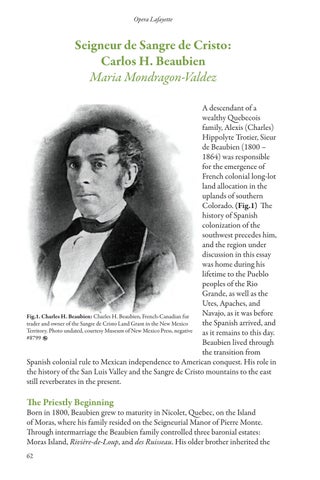Opera Lafayette
Seigneur de Sangre de Cristo: Carlos H. Beaubien Maria Mondragon-Valdez A descendant of a wealthy Quebecois family, Alexis (Charles) Hippolyte Trotier, Sieur de Beaubien (1800 – 1864) was responsible for the emergence of French colonial long-lot land allocation in the uplands of southern Colorado. (Fig.1) The history of Spanish colonization of the southwest precedes him, and the region under discussion in this essay was home during his lifetime to the Pueblo peoples of the Rio Grande, as well as the Utes, Apaches, and Navajo, as it was before Fig.1. Charles H. Beaubien: Charles H. Beaubien, French-Canadian fur the Spanish arrived, and trader and owner of the Sangre de Cristo Land Grant in the New Mexico Territory. Photo undated, courtesy Museum of New Mexico Press, negative as it remains to this day. #8799 Beaubien lived through the transition from Spanish colonial rule to Mexican independence to American conquest. His role in the history of the San Luis Valley and the Sangre de Cristo mountains to the east still reverberates in the present.
The Priestly Beginning
Born in 1800, Beaubien grew to maturity in Nicolet, Quebec, on the Island of Moras, where his family resided on the Seigneurial Manor of Pierre Monte. Through intermarriage the Beaubien family controlled three baronial estates: Moras Island, Rivière-de-Loup, and des Ruisseau. His older brother inherited the 62





